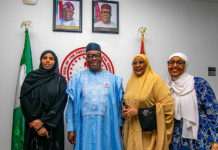Amina Ali Adan was born in the Kenyan town of Garissa, 65 miles away from Dadaab, one of the world’s largest refugee camps, situated near the Somali border. She is just one of tens of thousands of Kenyan citizens who have been registered as refugees — many while children. Now in her 30s and a mother of three, her life is defined by her lack of a Kenyan national ID.
Adan is a victim of what is known as double registration. Fleeing drought within the country’s borders in the 1990s, many ethnic Somali Kenyans falsely claimed to be escaping Somalia’s civil war, in order to access vital food aid. Now, because their details appear on biometric refugee databases, the very system responsible for protecting asylum seekers has effectively rendered them stateless.
“There are many challenges if you don’t have an ID,” Adan said. “If you want to open up a bank account, you need an ID. If you want to see someone in court, you will be asked for an ID. In Kenya, you cannot go anywhere without an ID.”
Without this crucial legal document, many political rights and economic entitlements are inaccessible in Kenya. They range from taking formal employment and registering a cell phone SIM card to opening a bank account and even entering government and business offices.
The outbreak of the Somali civil war in the early 1990s coincided with a drought in northeastern Kenya that drove tens of thousands of desperate citizens towards the camp. It was at this time that Adan, then five years old, was taken to Dadaab by her grandmother.
Faced with a vast influx of people, the United Nations High Commissioner for Refugees (UNHCR) — the global agency responsible for displaced people — struggled to distinguish between those uprooted by conflict in Somalia and ethnic Somalis with Kenyan citizenship. Because the boundary between Somalia and Kenya is highly porous and family networks often stretch across territories, many ethnic Somali Kenyans and their families were able to pass as refugees.
In Dadaab, ethnic Somali Kenyans could access food aid and education that, even as citizens of one of the country’s most marginalized regions, were often out of their reach. Another draw was the prospect of relocation in Europe or the U.S.
Adan’s grandmother could not have predicted that a seemingly harmless lie to feed herself and her granddaughter would have such serious implications so many years later. Over the past decade, tens of thousands of ethnic Somali Kenyans who have applied for a Kenyan national ID have been turned away on the grounds that they were already registered as refugees.
The root of this problem lies in an increasing global fervor for the collection of biometric data. In recent years, biometrics have become part of the global development agenda and a proposed panacea to a range of problems. One of the UN’s Sustainable Development Goals is to provide legal identity to all by 2030. International organizations ranging from the World Bank to the World Food Program, in conjunction with governments and multinational tech companies, have promoted the use of digital identity systems.
Nations across the global south have embraced this new technology. In countries including India, Ghana, Lebanon, Nigeria and South Africa, biometric identifiers are increasingly used in electoral processes, the distribution of aid, to gain access to financial services and to manage refugee populations.
The use of centralized, integrated biometric databases has been hailed as a definitive solution to the problem of identity fraud. In the early 2000s, the UNHCR began rolling out fingerprint and iris scans in refugee camps across the world. Biometric registration was first introduced to Kenya in 2007, in a bid to cut costs and reduce any further double registration.




